Efficient time management is integral to achieving productivity and success in both personal and professional endeavors. The daily to-do list stands out as a powerful tool in this regard. This article delves into the essence of a daily to-do list, elucidating its benefits and offering a concise, effective step-by-step guide on crafting one with the aid of a template. By understanding the core principles of daily planning and task organization, individuals can unlock their potential for increased efficiency and goal attainment.
What Is a Daily To-do List
A daily to-do list functions as a fundamental and potent organizational tool, aiding individuals in structuring their day effectively. This uncomplicated yet powerful method is akin to a personalized roadmap, guiding individuals through the intricacies of their daily tasks and responsibilities. It serves as a visual representation of the day's agenda, offering clarity on what needs attention and action.

The to-do list's simplicity is its strength, providing a tangible framework for daily activities. It not only outlines immediate tasks but also aids in long-term goal attainment by fostering a habit of consistent planning and execution. In essence, a daily to-do list is a versatile tool that adapts to individual needs, whether for personal tasks, work-related assignments, or a combination of both. As individuals integrate this tool into their routine, they gain control over their time, leading to heightened productivity and a more organized, purposeful daily life.
Benefits of a Daily To-Do List
In the hustle of contemporary life, mastering time is paramount. The daily to-do list, often underestimated, emerges as a pivotal tool. This part unveils its simplicity and power, navigating through benefits, transforming it from a list to a strategic blueprint for daily success.
- Clear Roadmap:
- The daily to-do list serves as a visual roadmap for the day, providing a concise overview of tasks and responsibilities.
- It acts as a guide, helping individuals prioritize and structure their day effectively.
- Stress Reduction:
- By breaking down tasks into manageable components, the to-do list alleviates the stress associated with an extensive workload.
- Task segmentation facilitates better time management, enabling individuals to approach each task with focused attention.
- Sense of Accomplishment:
-
-
- Checking off completed tasks on the to-do list generates a tangible sense of accomplishment.
- This sense of achievement serves as a motivator, encouraging individuals to maintain their momentum throughout the day.
-
- Promotes Proactive Mindset:
-
- Preemptive planning through the daily to-do list fosters a proactive mindset.
- Individuals are better prepared to face challenges and capitalize on opportunities, contributing to a more strategic and forward-thinking approach.
-
In essence, the daily to-do list is more than a mere organizational tool; it is a dynamic instrument that enhances daily routines by providing clarity, reducing stress, fostering motivation, and instilling a proactive mindset. Integrating this simple yet powerful practice into daily life can lead to significant improvements in productivity and overall well-being.
What Should Be on a Daily To-Do List
To craft an effective daily to-do list, a balanced selection of tasks is crucial. Begin by including a mix of high-priority projects and smaller, more manageable tasks. This diversity ensures a realistic and achievable list. Moreover, the list should encompass both personal and professional responsibilities, fostering a holistic approach to daily planning.
- High-Priority Projects:
- Incorporate tasks that contribute significantly to your overarching goals.
- These tasks demand focused attention and are typically time-sensitive.
- Smaller, Manageable Tasks:
- Break down larger projects into smaller, achievable steps.
- Including these tasks ensures continuous progress and prevents overwhelm.
- Personal Responsibilities:
- Integrate personal commitments into the to-do list.
- This can range from self-care activities to errands, ensuring a well-rounded approach to daily planning.
- Professional Responsibilities:
-
-
- Include work-related tasks, meetings, and deadlines.
- Align these with the broader goals of your professional endeavors.
-
By blending high-priority projects with smaller, manageable tasks, you strike a balance that promotes productivity without inducing stress. Simultaneously addressing personal and professional responsibilities ensures a holistic approach to daily planning. This method not only fosters a sense of accomplishment but also facilitates a well-rounded and sustainable daily routine.
How to Create a Daily To-Do List with Template
In a world teeming with daily tasks and responsibilities, an organized daily to-do list is a game-changer. Leveraging the power of Boardmix, a dynamic online task management platform, makes this process effortless. Boardmix, tailored for seamless daily task tracking, introduces the concepts of boards, lists, and cards to create visually appealing and easily navigable daily to-do lists.

Creating your daily to-do list with Boardmix is a user-friendly experience, ensuring accessibility for everyone. Here is a step-by-step instruction:
Step 1: Sign Up for a Free Account
Embark on your journey by signing up for a free account on the Boardmix website. Simply input your email address and establish a password to kickstart your account.

Step 2: Generate a New Board
Upon signing in, access your Boardmix account and select "New board" on your homepage. Give the board a name reflective of the daily tasks it will encapsulate.

Step 3: Utilize the Daily To-Do List Template
Once your board is set up, initiate the creation of your daily to-do list. Boardmix provides ready-made templates, streamlining the process for efficient task organization.
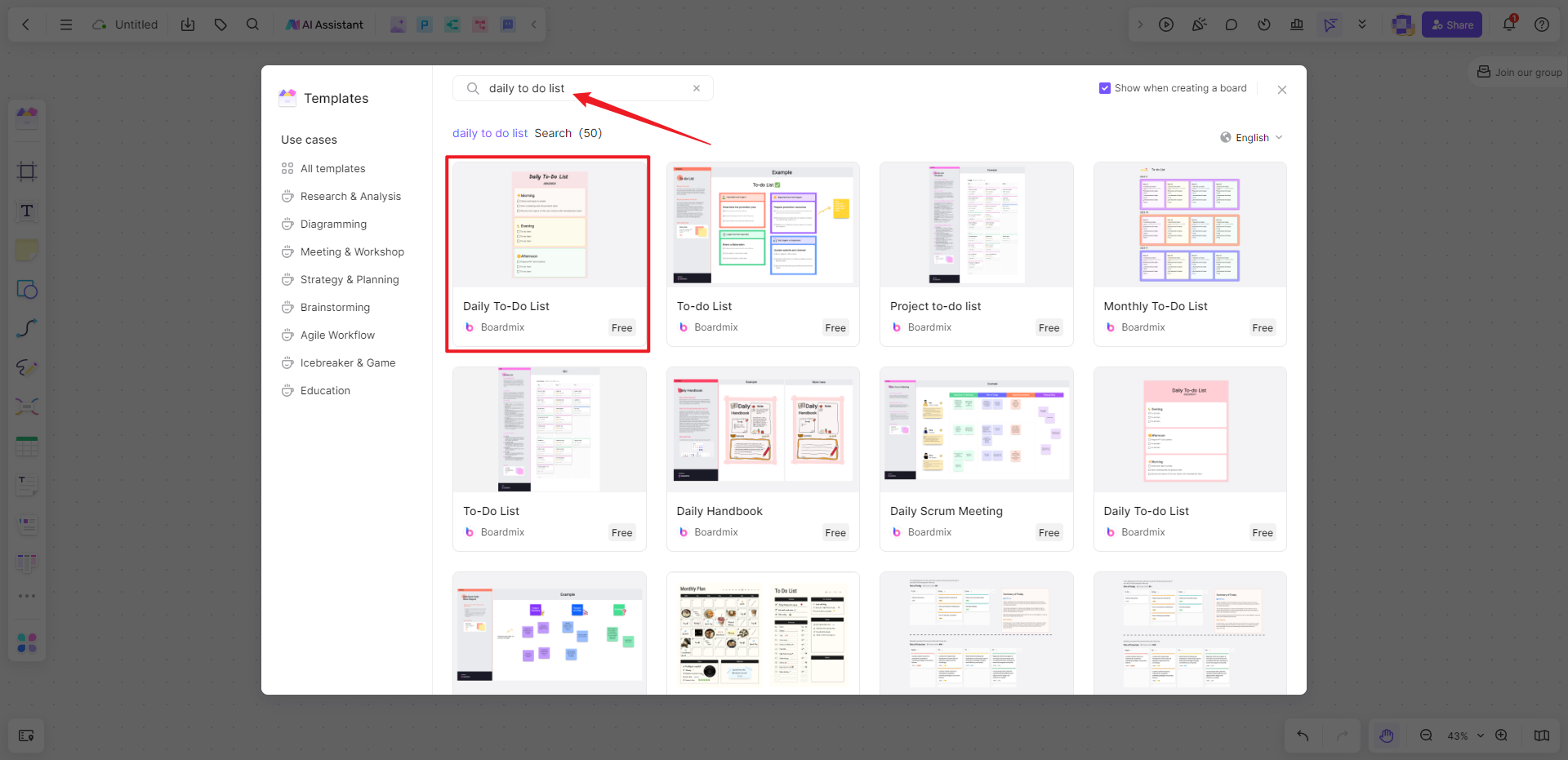
Step 4: Populate Your To-Do List
Enter your tasks into the template, utilizing its predefined sections or categories. This step streamlines the process, allowing you to focus on the content of your to-do list without the need to structure it from scratch.
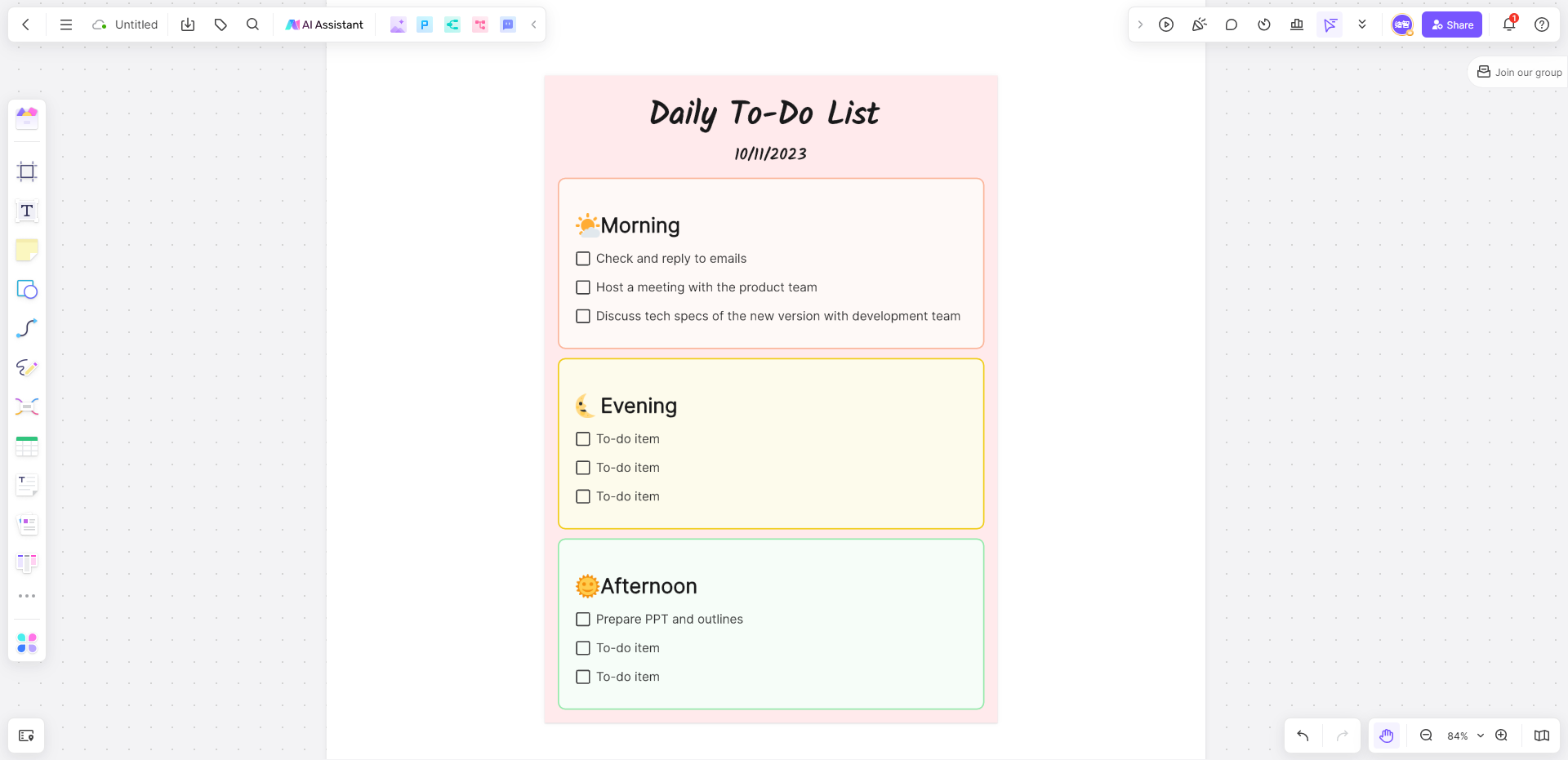
Step 5: Customize Your To-Do List
Incorporate descriptions, assign members, set due dates, attach files, and more to tailor your daily to-do list according to the intricacies of your tasks.

Step 6: Monitor Your Daily Progress
As you browse through your daily tasks, update the status of each task by ticking items in the list between lists.

In summary, Boardmix revolutionizes the conventional to-do list, transforming it into an interactive digital space. With its user-friendly interface and robust features, Boardmix makes managing your daily to-do list a seamless and engaging activity, ensuring optimal productivity.
Tips: How to List Priorities on a Daily To-Do List
Efficiently managing priorities on your daily to-do list is essential for ensuring productivity. Explore three potent methods – the 1-3-5 Rule, the 3-2-1 Rule, and the MoSCoW Technique – each crafted to address diverse task complexities and criticalities.
The 1-3-5 Rule
The 1-3-5 Rule is a strategic approach to prioritize tasks by their size and impact. Begin by identifying one significant task that holds paramount importance for the day. This task could be a major project, a critical deadline, or a high-impact assignment. Following this, select three medium tasks that contribute to overall progress without overwhelming your schedule. These tasks may involve important meetings, mid-priority projects, or critical follow-ups.
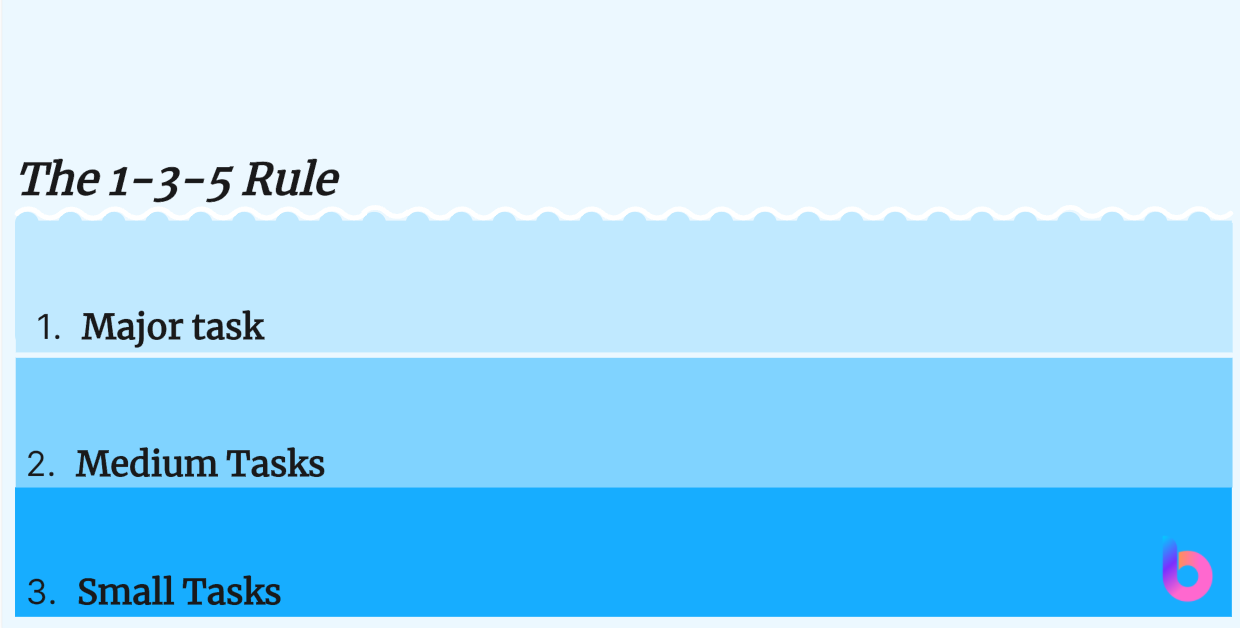
Finally, include five small tasks that are quick to accomplish yet contribute to the overall efficiency of your day. These could be routine tasks, emails, or minor adjustments. The 1-3-5 Rule ensures a balanced mix of high, medium, and low-intensity tasks, promoting a sense of accomplishment as you check items off throughout the day.
The 3-2-1 Rule
The 3-2-1 Rule simplifies prioritization further, offering a clear structure for your daily to-do list. Prioritize three tasks of varying complexity and importance. These could be significant work assignments, essential meetings, or crucial follow-ups. Following this, identify two tasks of medium importance – tasks that contribute to your progress but may not be as time-sensitive.
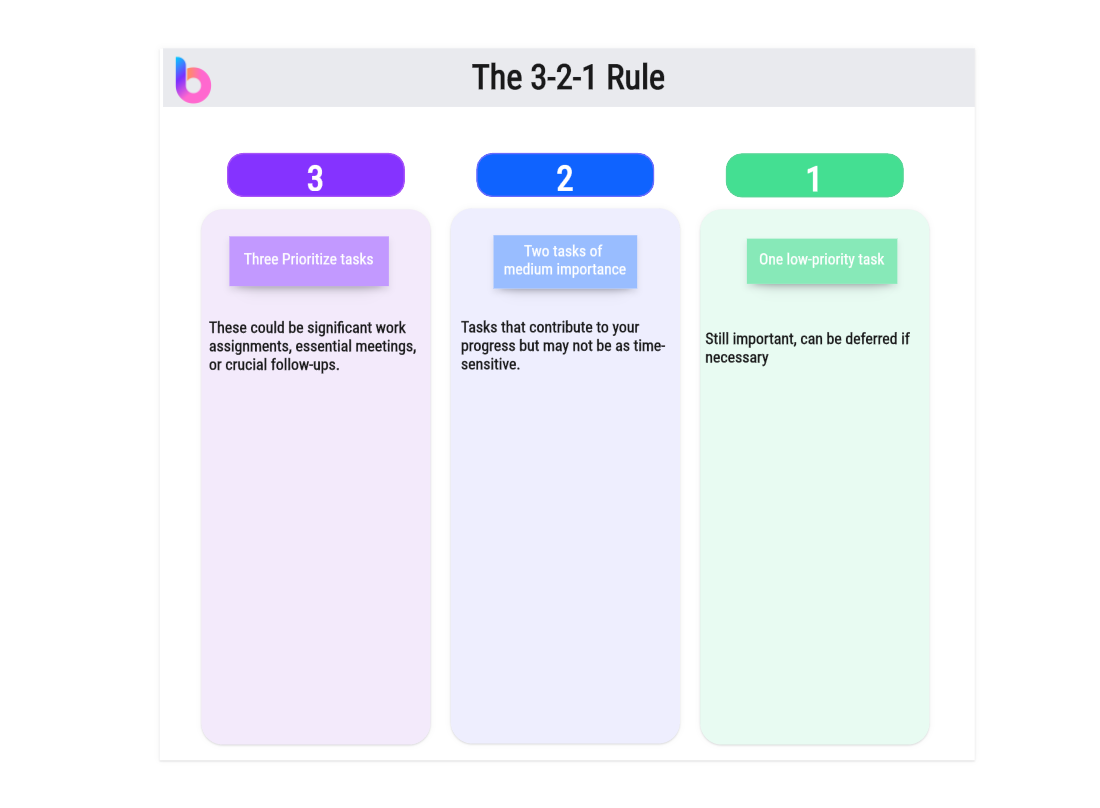
Conclude by including one low-priority task that, while still important, can be deferred if necessary. The 3-2-1 Rule ensures you focus on a handful of critical tasks while maintaining a balance with less urgent but essential activities.
The MoSCoW Technique
The MoSCoW Technique introduces a categorization system that helps determine the priority of each task. Divide your tasks into four categories:
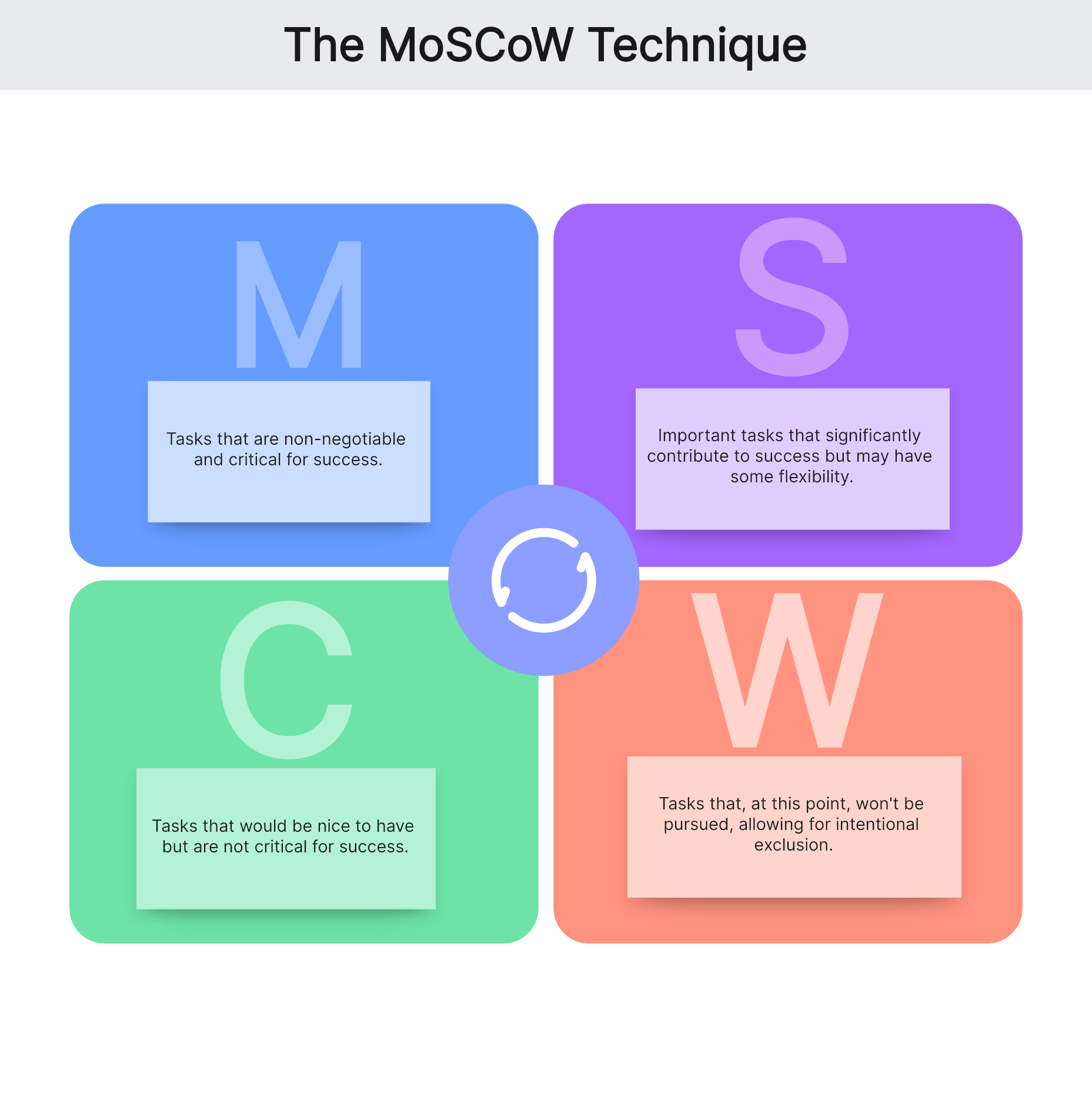
- Must-haves (M): Tasks that are non-negotiable and critical for success.
- Should-haves (S): Important tasks that significantly contribute to success but may have some flexibility.
- Could-haves (C): Tasks that would be nice to have but are not critical for success.
- Won't-haves (W): Tasks that, at this point, won't be pursued, allowing for intentional exclusion.
By categorizing tasks using MoSCoW, you gain a comprehensive view of their relative importance and urgency, enabling you to make informed decisions about where to allocate your time and energy. Incorporating these prioritization techniques into your daily to-do list with Boardmix empowers you to navigate tasks with precision, ensuring optimal productivity and achievement of your overarching goals.













